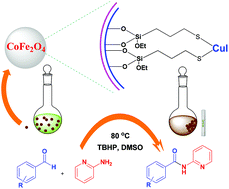CuI incorporated cobalt ferrite nanoparticles as a magnetically separable catalyst for oxidative amidation reaction†
Abstract
A Cu-incorporated magnetic nanocatalyst (CoFe2O4@SiO2-SH-CuI) has been developed by immobilizing CuI on the modified surface of CoFe2O4 magnetic nanoparticles. The surface of the silica coated cobalt ferrite magnetic core was first treated with 3-mercaptopropyl triethoxysilane to produce the thiol functionalized nanoparticle CoFe2O4@SiO2-SH. Further treatment of the nanoparticle with CuI produced the desired magnetic nanocatalyst. The versatility of the catalyst has been demonstrated for the synthesis of N-(pyridin-2-yl) benzamide via oxidative amidation of aryl aldehydes with 2-amino pyridine in the presence of an oxidant. The reaction was carried out in DMSO at 80 °C using TBHP (70% aqueous) in the presence of 20 wt% of the catalyst. Notably, the catalyst could be separated from the reaction mixture in the presence of an external magnetic field. During the study, a new compound N-(pyridin-2-yl)anthracene-2-carboxamide has been synthesized and its turn on fluorescence sensing properties towards various metal ions have been studied. Fluorescence experiments and theoretical studies indicated that the newly synthesized carboxamide molecule can be used for fluorescence sensing of the Hg2+ ion in aqueous solution.



 Please wait while we load your content...
Please wait while we load your content...